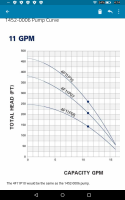I have a 200ft well with the pump sitting at about 180ft.
The pump currently in the well is a 1HP Zoeller from Lowes (1452-0006 - https://www.zoellerathome.com/content/literature/025095-Zoeller-4inSub-Instr-2-wire.pdf). Supposed to be 10GPM at 175ft.
I have an 86 Gallon A.O. Smith pressure tank with a 23 gallon draw down on a 40/60 pressure switch.
I'm having issues where it is not refilling the pressure tank as quickly as it used to and when the pump kicks on and i'm in the shower, the pressure is very low and is the only device on in the house. I've also jumped out and made sure the pressure drop wasn't just in the shower by turning on another faucet and it wasn't. Shower is 2.5gpm max if the valve I have activates the shower head and shower wand.
I had a similar problem prevously with a 4 year old Aermotor pump (1/2HP) last year but the pressure there was less than with this Zoeller pump. It was a trickle in comparison. This Zoeller pump was put in to replace it.
I have been looking at Grundfos pumps thinking part of the issue was that i'm not sure Aermotor or Zoeller at home are quality pumps. I also think possibly the Aermotor pump was undersized at 1/2hp and sitting at almost 200ft and the Zoeller may be overpowered?
I was looking at the Grundfos 16S07-8 (10154508) 2 wire, 230v. Looking at the specs and reading the pump curve as well as I could given my well depth and where the pump sits (180ft) this seemed to be a good fit with my pressure tank (86 gallon, 23gallon draw down). I did pull an old well report from when it was drilled:
Hours pumped: 3hr
Pumping Rate: 4gpm
Before pumping: 34 ft
When pumping: 200 ft
I'm imagining that the Zoeller pump may be going bad after only being installed for about 6 months. My well does has some sediment and I imagine that impacts the quality and I was thinking Grundfos being a good brand with a stainless impeller would be an advantage. Is this a good pump? Any comments on any of what I said that i'm completely overlooking?
The pump currently in the well is a 1HP Zoeller from Lowes (1452-0006 - https://www.zoellerathome.com/content/literature/025095-Zoeller-4inSub-Instr-2-wire.pdf). Supposed to be 10GPM at 175ft.
I have an 86 Gallon A.O. Smith pressure tank with a 23 gallon draw down on a 40/60 pressure switch.
I'm having issues where it is not refilling the pressure tank as quickly as it used to and when the pump kicks on and i'm in the shower, the pressure is very low and is the only device on in the house. I've also jumped out and made sure the pressure drop wasn't just in the shower by turning on another faucet and it wasn't. Shower is 2.5gpm max if the valve I have activates the shower head and shower wand.
I had a similar problem prevously with a 4 year old Aermotor pump (1/2HP) last year but the pressure there was less than with this Zoeller pump. It was a trickle in comparison. This Zoeller pump was put in to replace it.
I have been looking at Grundfos pumps thinking part of the issue was that i'm not sure Aermotor or Zoeller at home are quality pumps. I also think possibly the Aermotor pump was undersized at 1/2hp and sitting at almost 200ft and the Zoeller may be overpowered?
I was looking at the Grundfos 16S07-8 (10154508) 2 wire, 230v. Looking at the specs and reading the pump curve as well as I could given my well depth and where the pump sits (180ft) this seemed to be a good fit with my pressure tank (86 gallon, 23gallon draw down). I did pull an old well report from when it was drilled:
Hours pumped: 3hr
Pumping Rate: 4gpm
Before pumping: 34 ft
When pumping: 200 ft
I'm imagining that the Zoeller pump may be going bad after only being installed for about 6 months. My well does has some sediment and I imagine that impacts the quality and I was thinking Grundfos being a good brand with a stainless impeller would be an advantage. Is this a good pump? Any comments on any of what I said that i'm completely overlooking?

